Effects of the Preferential Oxidation of Phenolic Lignin Using Chlorine Dioxide on Pulp Bleaching Efficiency
Abstract
1. Introduction
2. Results and Discussion
2.1. Oxidative Consumption of Vanillyl Alcohol and Veratryl Alcohol by Chlorine Dioxide
2.2. Differences in Oxidation Products
2.3. Analysis of Physicochemical Properties of Pulp Fibers
2.4. Structural Transformation of Lignin in Pulp
3. Materials and Methods
3.1. Materials and Reagents
3.2. Oxidation of Lignin by Chlorine Dioxide
3.3. Organic Components in the Reaction Solution
3.4. Chlorine Dioxide Oxidation of Pulp
3.5. Structural Characteristics of Lignin in Pulp
3.6. Physical and Chemical Characterization of the Pulp
4. Conclusions
Author Contributions
Funding
Informed Consent Statement
Data Availability Statement
Conflicts of Interest
References
- Zhang, S.; Chi, M.; Mo, J.; Liu, T.; Liu, Y.; Fu, Q.; Wang, J.; Luo, B.; Qin, Y.; Wang, S.; et al. Bioinspired asymmetric amphiphilic surface for triboelectric enhanced efficient water harvesting. Nat. Commun. 2022, 13, 4168. [Google Scholar] [CrossRef] [PubMed]
- Zeng, H.; Liu, B.; Li, J.; Li, M.; Peng, M.; Qin, C.; Liang, C.; Huang, C.; Li, X.; Yao, S. Efficient separation of bagasse lignin by freeze–thaw-assisted p-toluenesulfonic acid pretreatment. Bioresour. Technol. 2022, 351, 126951. [Google Scholar] [CrossRef] [PubMed]
- Zeng, F.; Wang, S.; Liang, J.; Cao, L.; Liu, X.; Qin, C.; Liang, C.; Si, C.; Yu, Z.; Yao, S. High-efficiency separation of hemicellulose from bamboo by one-step freeze-thaw-assisted alkali treatment. Bioresour. Technol. 2022, 361, 127735. [Google Scholar] [CrossRef] [PubMed]
- Qin, Y.; Mo, J.; Liu, Y.; Zhang, S.; Wang, J.; Fu, Q.; Wang, S.; Nie, S. Stretchable Triboelectric Self-Powered Sweat Sensor Fabricated from Self-Healing Nanocellulose Hydrogels. Adv. Funct. Mater. 2022, 32, 2201846. [Google Scholar] [CrossRef]
- Peng, M.; Zhu, J.; Luo, Y.; Li, T.; Xia, X.; Qin, C.; Liang, C.; Bian, H.; Yao, S. Enhancement of separation selectivity of hemicellulose from bamboo using freeze–thaw-assisted p-toluenesulfonic acid treatment at low acid concentration and high temperature. Bioresour. Technol. 2022, 363, 127879. [Google Scholar] [CrossRef]
- Giannetti, B.F.; Agostinho, F.; Eras, J.J.C.; Yang, Z.; Almeida, C.M.V.B. Cleaner production for achieving the sustainable development goals. J. Clean. Prod. 2020, 271, 122127. [Google Scholar] [CrossRef]
- Khalili, N.R.; Duecker, S.; Ashton, W.; Chavez, F. From cleaner production to sustainable development: The role of academia. J. Clean. Prod. 2015, 96, 30–43. [Google Scholar] [CrossRef]
- Rodriguez, A.; Moral, A.; Serrano, L.; Labidi, J.; Jimenez, L. Rice straw pulp obtained by using various methods. Bioresour. Technol. 2008, 99, 2881–2886. [Google Scholar] [CrossRef]
- Rattanawongkun, P.; Kerddonfag, N.; Tawichai, N.; Intatha, U.; Soykeabkaew, N. Improving agricultural waste pulps via self-blending concept with potential use in moulded pulp packaging. J. Environ. Chem. Eng. 2020, 8, 104320. [Google Scholar] [CrossRef]
- Yu, C.; Shi, L.; Wang, Y.T.; Chang, Y.; Cheng, B.D. The eco-efficiency of pulp and paper industry in China: An assessment based on slacks-based measure and Malmquist-Luenberger index. J. Clean. Prod. 2016, 127, 511–521. [Google Scholar] [CrossRef]
- Zhang, X.; Li, J.; Gong, J.; Kuang, Y.; He, S.; Xu, J.; Mo, L.; Man, Y.; Zhu, W.; Song, J.; et al. Cleaner approach for medium consistency eucalyptus slab pulp production using ozone bleaching under turbulent mixing. J. Clean. Prod. 2020, 276, 124201. [Google Scholar] [CrossRef]
- Zhu, H.X.; Yao, S.Q.; Jiang, L.; Wang, S.F.; Qin, C.R. Kinetics of Adsorbable Organic Halogen Formation During the First Chlorine Dioxide Bleaching Stage of Eucalyptus Kraft Pulp. Bioresources 2016, 11, 8820–8830. [Google Scholar] [CrossRef][Green Version]
- Ferdous, T.; Quaiyyum, M.A.; Jahan, M.S. Characterization and Pulping of Crops Residue: Eggplant, Cassava, Okra and Mulberry Plants. Waste Biomass Valorization 2021, 12, 3161–3168. [Google Scholar] [CrossRef]
- Tarvo, V.; Lehtimaa, T.; Kuitunen, S.; Alopaeus, V.; Vuorinen, T.; Aittamaa, J. A Model for Chlorine Dioxide Delignification of Chemical Pulp. J. Wood Chem. Technol. 2010, 30, 230–268. [Google Scholar] [CrossRef]
- Lehtimaa, T.; Tarvo, V.; Kuitunen, S.; Jaaskelainen, A.S.; Vuorinen, T. The Effect of Process Variables in Chlorine Dioxide Prebleaching of Birch Kraft Pulp. Part 2. AOX and OX Formation. J. Wood Chem. Technol. 2010, 30, 19–30. [Google Scholar] [CrossRef]
- Liu, B.; Qin, C.; Zhang, F.; Wang, S.; Liang, C.; Nie, S.; Wang, S.; Yao, S. Reaction Mechanism of Phenolic Lignin and High Concentration Chlorine Dioxide and Its Application. ACS Omega 2020, 5, 22475–22481. [Google Scholar] [CrossRef]
- Starrsjo, S.; Sevastyanova, O.; Sandstrom, P.; Fiskari, J.; Boman, M.; Lindstrom, M.E. Reduction of adsorbable organically bound halogens (AOX) formation at near-neutral pH chlorine dioxide bleaching of softwood kraft pulp. Holzforschung 2020, 74, 597–604. [Google Scholar] [CrossRef]
- Nie, S.X.; Wu, Z.M.; Liu, J.C.; Liu, X.L.; Qin, C.R.; Song, H.N.; Wang, S.F. Optimization of AOX formation during the first chlorine dioxide bleaching stage (D-0) of soda AQ bagasse pulp. Appita Technol. Innov. Manuf. Environ. 2013, 66, 306–312. [Google Scholar]
- Chenna, N.K.; Jaaskelainen, A.S.; Vuorinen, T. Rapid and Selective Catalytic Oxidation of Hexenuronic Acid and Lignin in Cellulosic Fibers. Ind. Eng. Chem. Res. 2013, 52, 17744–17749. [Google Scholar] [CrossRef]
- Isaza Ferro, E.; Ruuttunen, K.; Perrin, J.; Vuorinen, T. Sustainable bleaching of Eucalyptus sp. kraft pulp with hypochlorous acid, ozone and hydrogen peroxide. Ind. Crops Prod. 2021, 172, 114004. [Google Scholar] [CrossRef]
- Yao, S.Q.; Nie, S.X.; Zhu, H.X.; Wang, S.F.; Song, X.P.; Qin, C.R. Extraction of hemicellulose by hot water to reduce adsorbable organic halogen formation in chlorine dioxide bleaching of bagasse pulp. Ind. Crops Prod. 2017, 96, 178–185. [Google Scholar] [CrossRef]
- Sharma, A.; Thakur, V.V.; Shrivastava, A.; Jain, R.K.; Mathur, R.M.; Gupta, R.; Kuhad, R.C. Xylanase and laccase based enzymatic kraft pulp bleaching reduces adsorbable organic halogen (AOX) in bleach effluents: A pilot scale study. Bioresour. Technol. 2014, 169, 96–102. [Google Scholar] [CrossRef] [PubMed]
- Zhang, H.C.; Nie, S.X.; Qin, C.R.; Wang, S.F. Removal of hexenuronic acid to reduce AOX formation in hot chlorine dioxide bleaching of bagasse pulp. Ind. Crops Prod. 2019, 128, 338–345. [Google Scholar] [CrossRef]
- Zhang, H.C.; Nie, S.X.; Qin, C.R.; Zhang, K.; Wang, S.F. Effect of hot chlorine dioxide delignification on AOX in bagasse pulp wastewater. Cellulose 2018, 25, 2037–2049. [Google Scholar] [CrossRef]
- Lachenal, D.; Joncourt, M.J.; Froment, P.; Chirat, C. Reduction of the formation of AOX during chlorine dioxide bleaching. J. Pulp Pap. Sci. 1998, 24, 14–17. [Google Scholar]
- Li, Y.; Cao, L.M.; Gu, K.Q.; Wang, X.Y.; Pang, Y.B.; Wu, Q.; Yao, S.Q. Reducing the Formation of Adsorbable Organic Halides Using an Ammonium Thiosulfate Chlorine Dioxide Bleaching Process. Bioresources 2020, 15, 8677–8688. [Google Scholar] [CrossRef]
- Joncourt, M.J.; Froment, P.; Lachenal, D.; Chirat, C. Reduction of AOX formation during chlorine dioxide bleaching. Tappi J. 2000, 83, 144–148. [Google Scholar]
- Ni, Y.; Shen, X.; van Heiningen, A.R.P. Studies on the Reactions of Phenolic and Non-Phenolic Lignin Model Compounds with Chlorine Dioxide. J. Wood Chem. Technol. 1994, 14, 243–262. [Google Scholar] [CrossRef]
- Lachenal, D.; Hamzeh, Y.; Chirat, C.; Mortha, G. Getting the Best from Chlorine Dioxide Bleaching. J. Pulp Pap. Sci. 2008, 34, 9–12. [Google Scholar]
- Shi, L.; Ge, J.; Zhang, F.; Nie, S.; Qin, C.; Yao, S. Difference in adsorbable organic halogen formation between phenolic and non-phenolic lignin model compounds in chlorine dioxide bleaching. R. Soc. Open Sci. 2019, 6, 191202. [Google Scholar] [CrossRef]
- Shi, L.; Ge, J.; Nie, S.; Qin, C.; Yao, S. Effect of lignin structure on adsorbable organic halogens formation in chlorine dioxide bleaching. R. Soc. Open Sci. 2019, 6, 182024. [Google Scholar] [CrossRef] [PubMed]
- Lehtimaa, T.; Tarvo, V.; Kuitunen, S.; Jaaskelainen, A.S.; Vuorinen, T. The Effect of Process Variables in Chlorine Dioxide Prebleaching of Birch Kraft Pulp. Part 1. Inorganic Chlorine Compounds, Kappa Number, Lignin, and Hexenuronic Acid Content. J. Wood Chem. Technol. 2010, 30, 1–18. [Google Scholar] [CrossRef]
- Sezgi, U.; Resende, J.; Shackford, L.; Colodette, J.L.; Andrade, M.F. Effects of D-0-stage temperature, pH, and kappa factor on chlorine dioxide decomposition and D-0-(EP)-D-1 bleaching performance for eucalypt pulps. Tappi J. 2016, 15, 285–295. [Google Scholar] [CrossRef]
- Hsieh, P.; Liu, C.R.; Ko, C.H.; Yang, B.Y.; Lin, P.H. Effects of Residual Phenolic Compounds on Xylanase-assisted ClO2 Bleaching of Hardwood Kraft Pulp. Bioresources 2021, 16, 8111–8124. [Google Scholar] [CrossRef]
- Huang, Y.; Li, H.; Zhou, Q.; Li, A.M.; Shuang, C.D.; Xian, Q.M.; Xu, B.; Pan, Y. New phenolic halogenated disinfection byproducts in simulated chlorinated drinking water: Identification, decomposition, and control by ozone-activated carbon treatment. Water Res. 2018, 146, 298–306. [Google Scholar] [CrossRef]
- Erhardt, C.S.; Basegio, T.M.; Capela, I.; Rodríguez, A.L.; Machado, Ê.L.; López, D.A.R.; Tarelho, L.; Bergmann, C.P. AOX degradation of the pulp and paper industry bleaching wastewater using nZVI in two different agitation processes. Environ. Technol. Innov. 2021, 22, 101420. [Google Scholar] [CrossRef]
- Ma, Q.; Hirth, K.; Agarwal, U.P.; Zhu, J.Y. Oxidative delignification: The roles of lignin reactivity and accessibility. J. Clean. Prod. 2022, 363, 132351. [Google Scholar] [CrossRef]
- Zhong, X.; Yuan, R.; Zhang, B.; Wang, B.; Chu, Y.; Wang, Z. Full fractionation of cellulose, hemicellulose, and lignin in pith-leaf containing corn stover by one-step treatment using aqueous formic acid. Ind. Crops Prod. 2021, 172, 113962. [Google Scholar] [CrossRef]
- Gu, S.; Choi, J.-W.; Lee, H.; Suh, D.J.; Choi, J.; Ha, J.-M. Improved catalytic depolymerization of lignin waste using carbohydrate derivatives. Environ. Pollut. 2021, 268, 115674. [Google Scholar] [CrossRef]
- Chang, Y.-H.; Lin, C.-L.; Hsu, Y.-H.; Lin, J.-H. Medium effect on acid degradation of cotton and wood celluloses. Ind. Crops Prod. 2021, 167, 113540. [Google Scholar] [CrossRef]
- Kaur, D.; Bhardwaj, N.K.; Lohchab, R.K. A study on pulping of rice straw and impact of incorporation of chlorine dioxide during bleaching on pulp properties and effluents characteristics. J. Clean. Prod. 2018, 170, 174–182. [Google Scholar] [CrossRef]
- Latham, K.G.; Matsakas, L.; Figueira, J.; Rova, U.; Christakopoulos, P.; Jansson, S. Examination of how variations in lignin properties from Kraft and organosolv extraction influence the physicochemical characteristics of hydrothermal carbon. J. Anal. Appl. Pyrolysis 2021, 155, 105095. [Google Scholar] [CrossRef]
- Feng, C.; Zhu, J.; Hou, Y.; Qin, C.; Chen, W.; Nong, Y.; Liao, Z.; Liang, C.; Bian, H.; Yao, S. Effect of temperature on simultaneous separation and extraction of hemicellulose using p-toluenesulfonic acid treatment at atmospheric pressure. Bioresour. Technol. 2022, 348, 126793. [Google Scholar] [CrossRef]
- Qin, C.; Zeng, H.; Liu, B.; Zhu, J.; Wang, F.; Wang, S.; Liang, C.; Huang, C.; Ma, J.; Yao, S. Efficient removal of residual lignin from eucalyptus pulp via high-concentration chlorine dioxide treatment and its effect on the properties of residual solids. Bioresour. Technol. 2022, 360, 127621. [Google Scholar] [CrossRef]
- Nicolau dos Santos, G.; José Alves Felisardo, R.; Gomes Galrão, D.; Paulo Rosa Barbosa, M.; Menezes Santos, R.; Francisco da Silva, G.; dos Santos Freitas, L.; Maria Egues Dariva, S.; Garcia-Segura, S.; Bezerra Cavalcanti, E. Electroflotation enables treatment of effluents generated during pyrolytic biomass revalorization. Sep. Purif. Technol. 2021, 277, 119458. [Google Scholar] [CrossRef]
- Yao, L.; Hu, S.; Wang, X.; Lin, M.; Zhang, C.; Chen, Y.; Yue, F.; Qi, H. Facile preparation of lignin-containing cellulose nanofibrils from sugarcane bagasse by mild soda-oxygen pulping. Carbohydr. Polym. 2022, 290, 119480. [Google Scholar] [CrossRef]
- Feng, C.; Zhu, J.; Cao, L.; Yan, L.; Qin, C.; Liang, C.; Yao, S. Acidolysis mechanism of lignin from bagasse during p-toluenesulfonic acid treatment. Ind. Crops Prod. 2022, 176, 114374. [Google Scholar] [CrossRef]
- Deng, B.; Hou, Y.; Wang, F.; Bao, Y.; Zeng, F.; Qin, C.; Liang, C.; Huang, C.; Ma, J.; Yao, S. Highly selective separation of eucalyptus hemicellulose by salicylic acid treatment with both aromatic and hydroxy acids. Bioresour. Technol. 2022, 355, 127304. [Google Scholar] [CrossRef]
- Sharma, N.; Tripathi, S.K.; Bhardwaj, N.K. Utilization of sarkanda for making pulp and paper using elemental chlorine free and total chlorine free bleaching processes. Ind. Crops Prod. 2020, 149, 112316. [Google Scholar] [CrossRef]
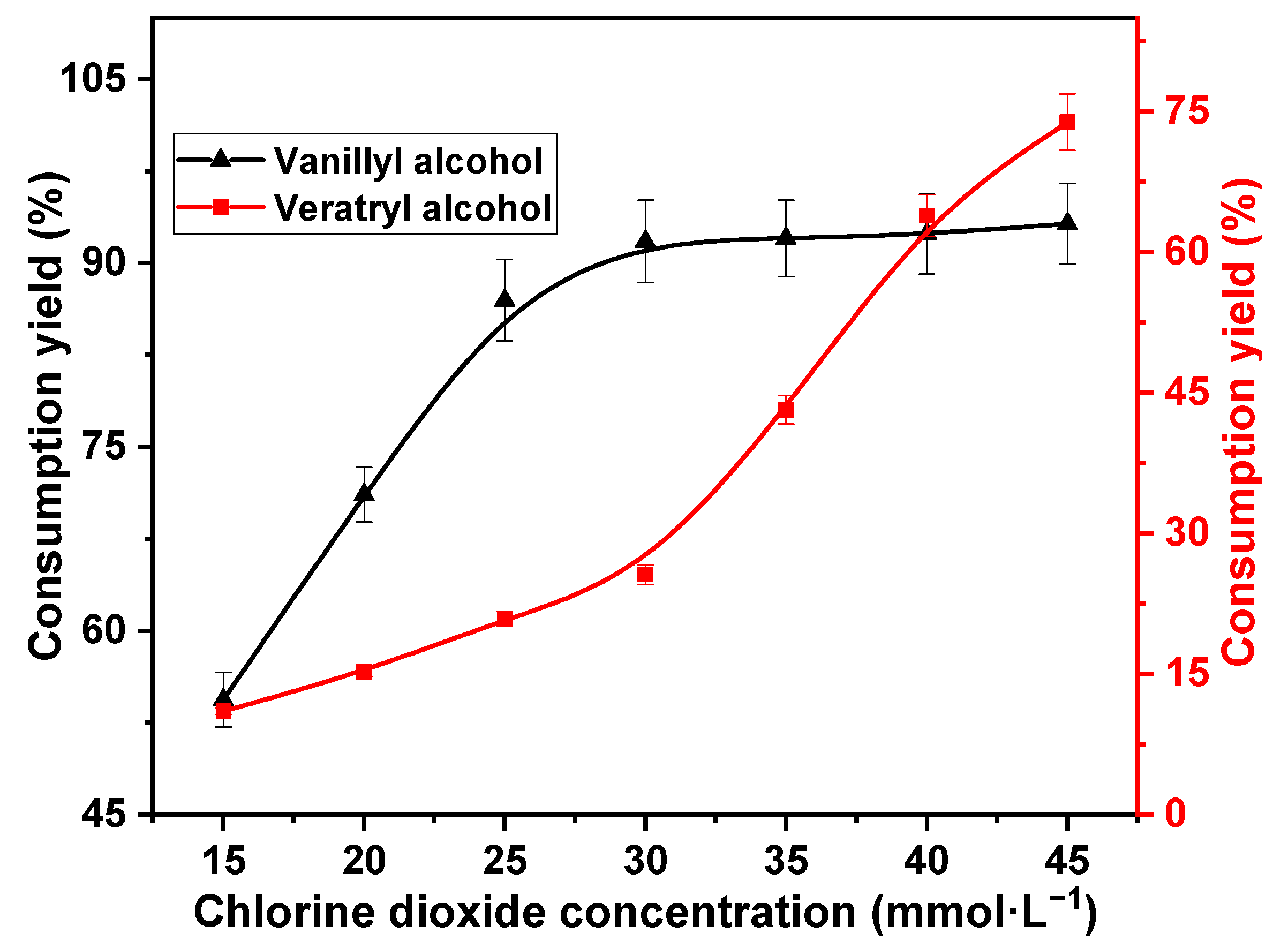
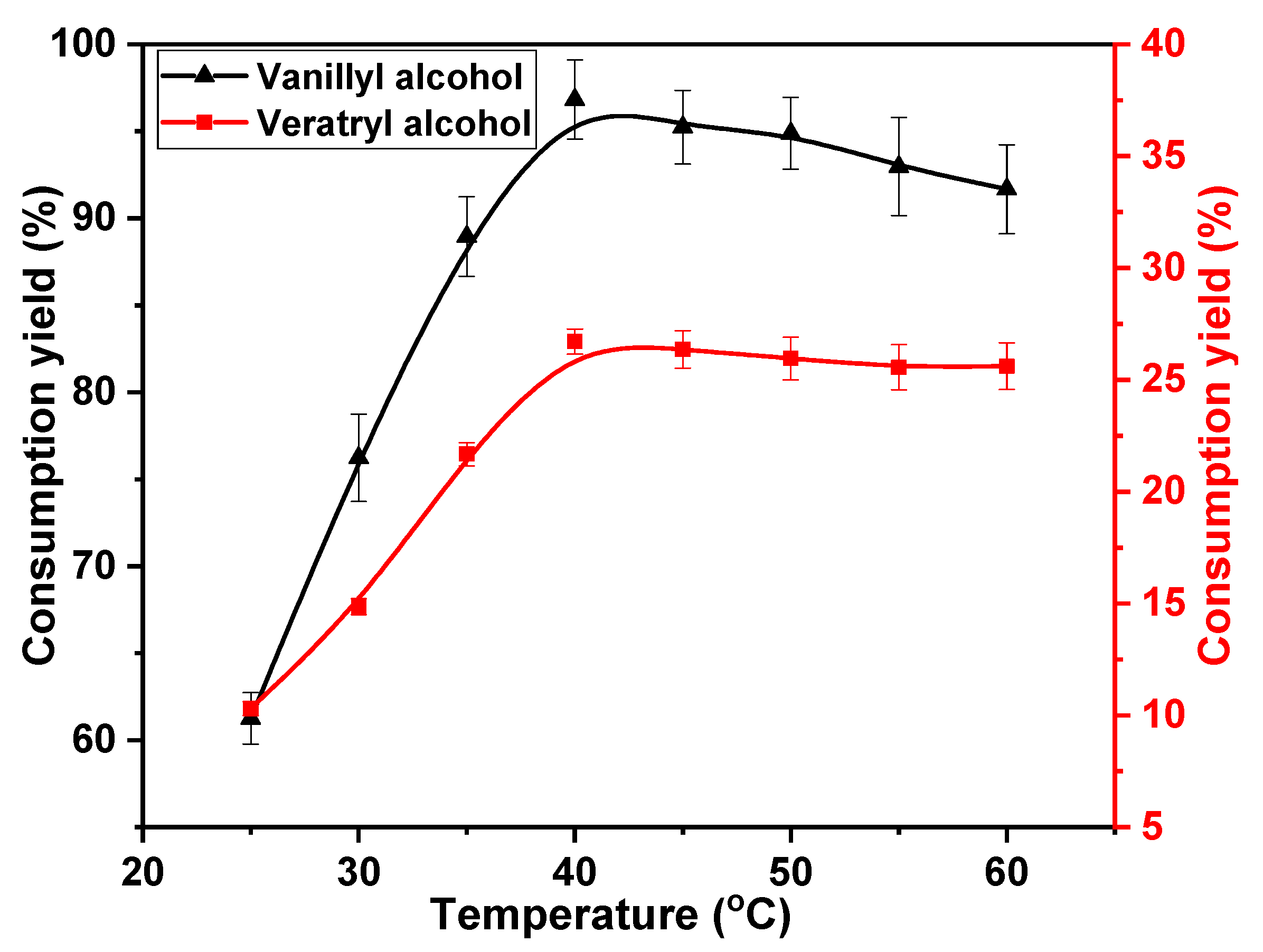
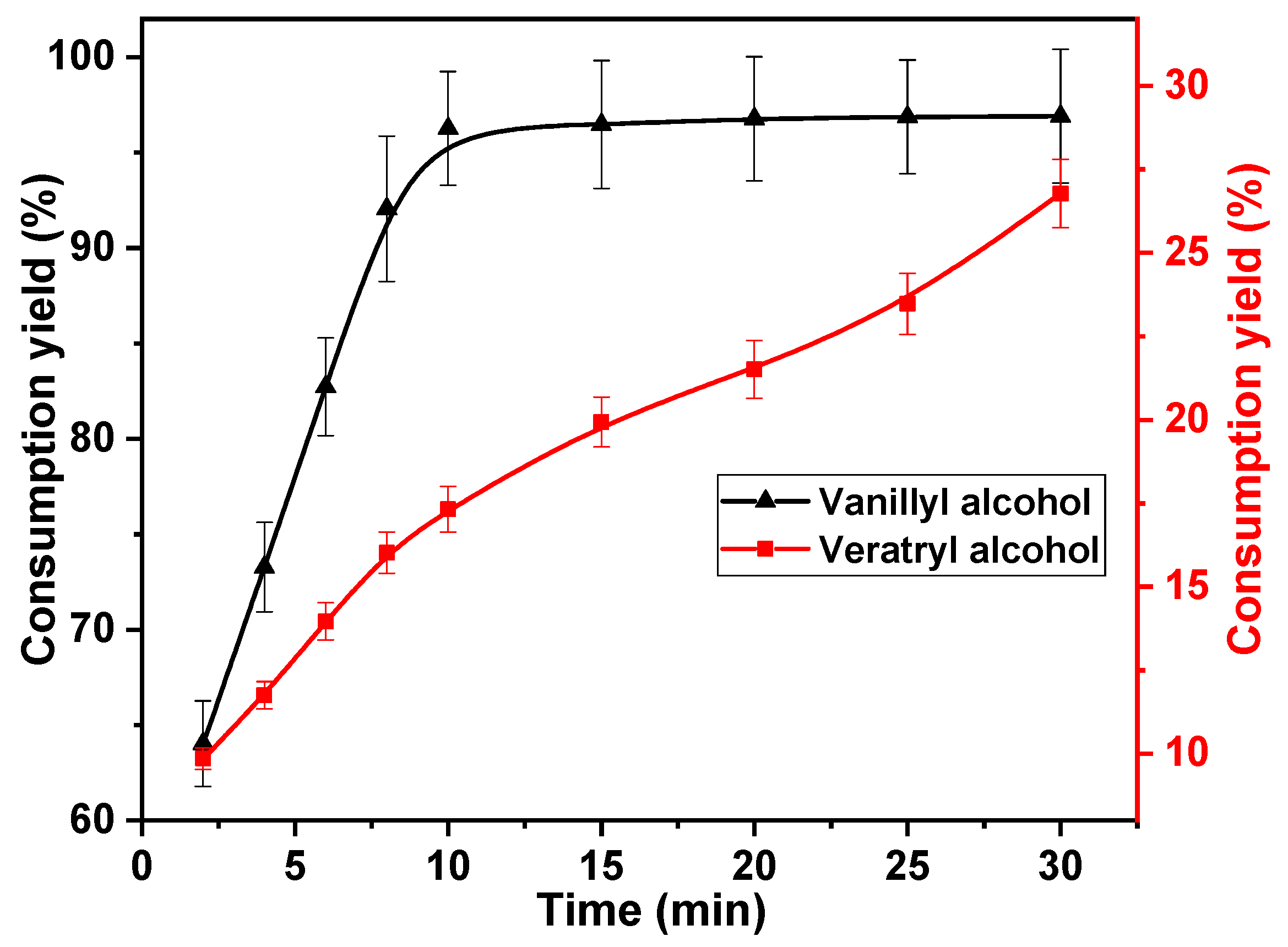
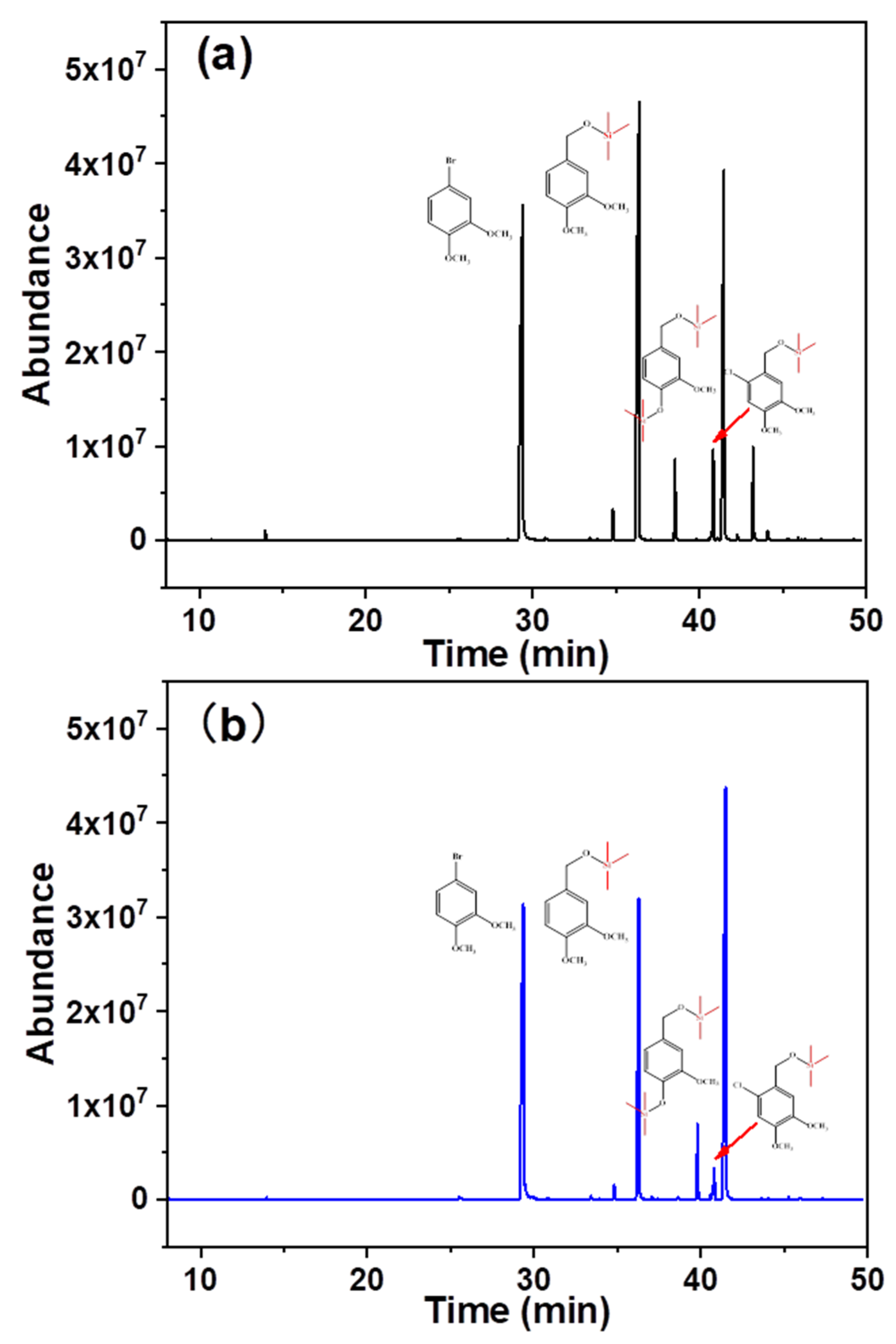

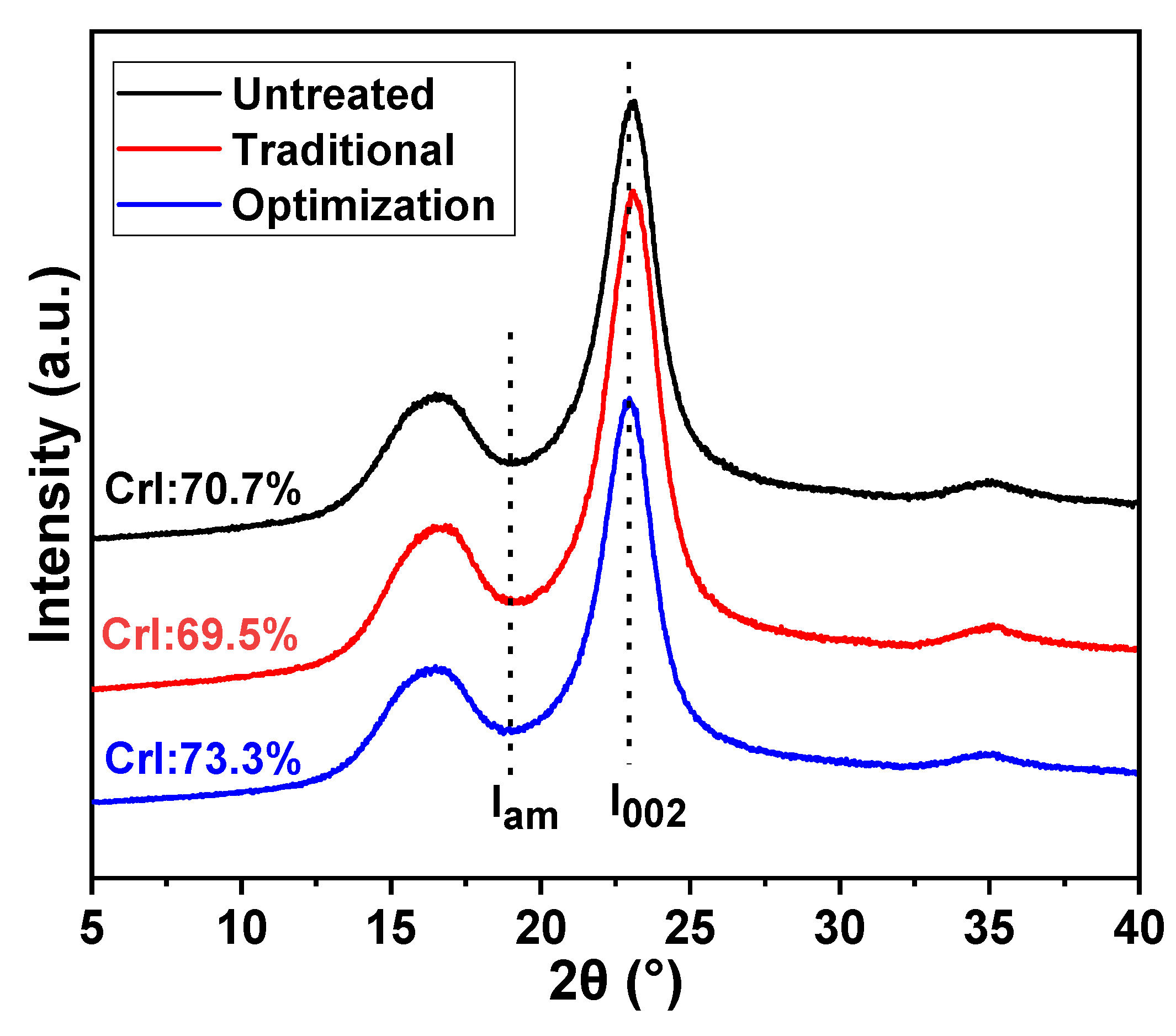
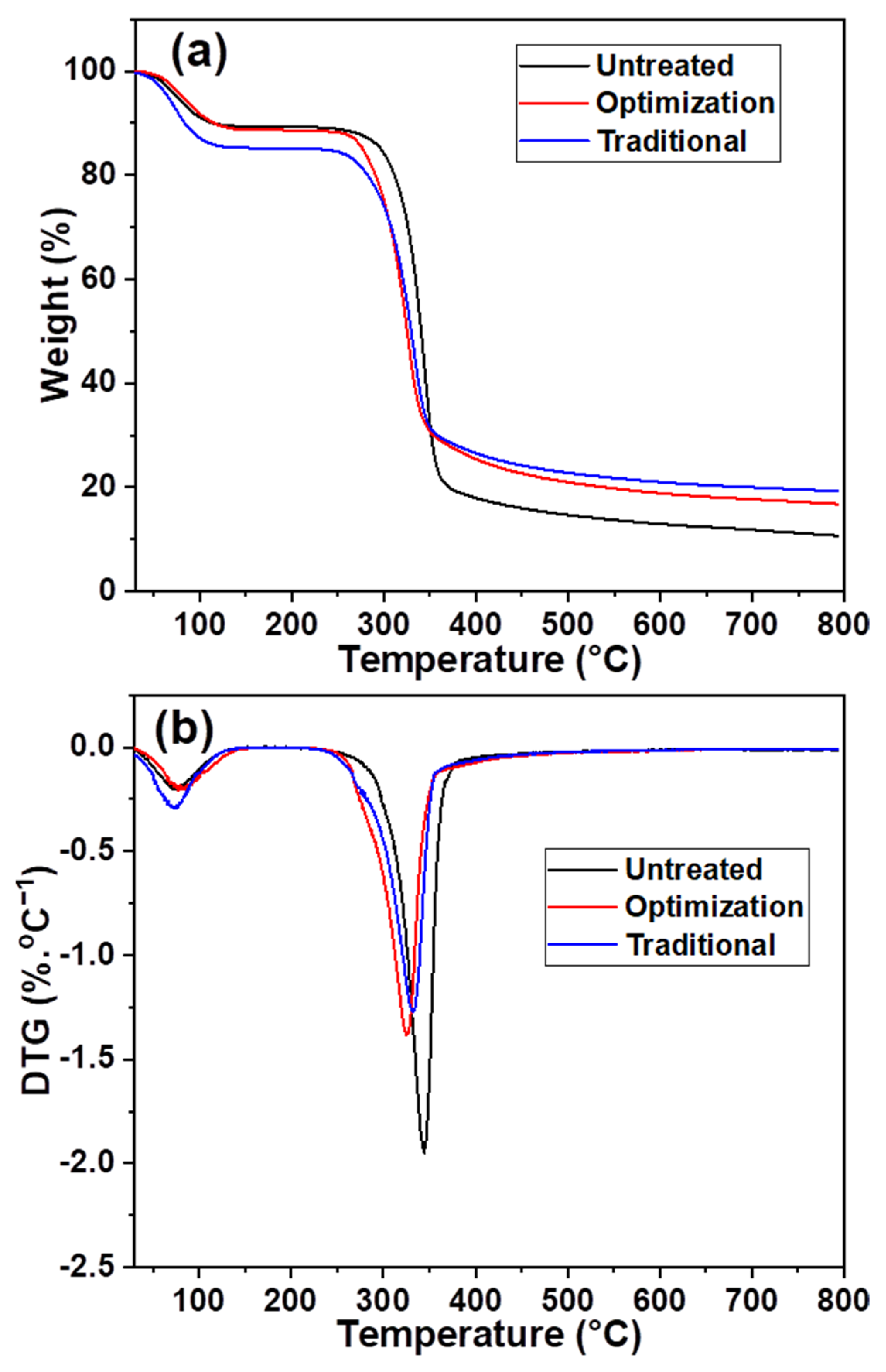
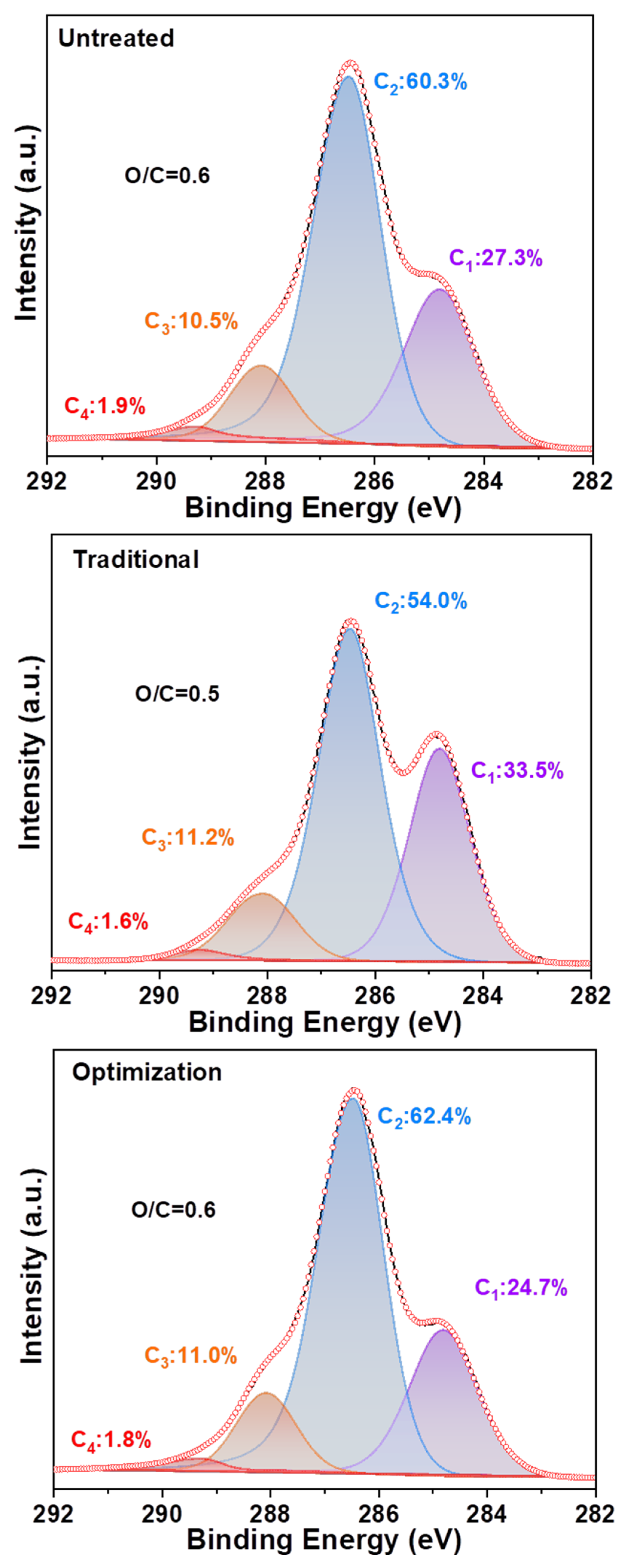
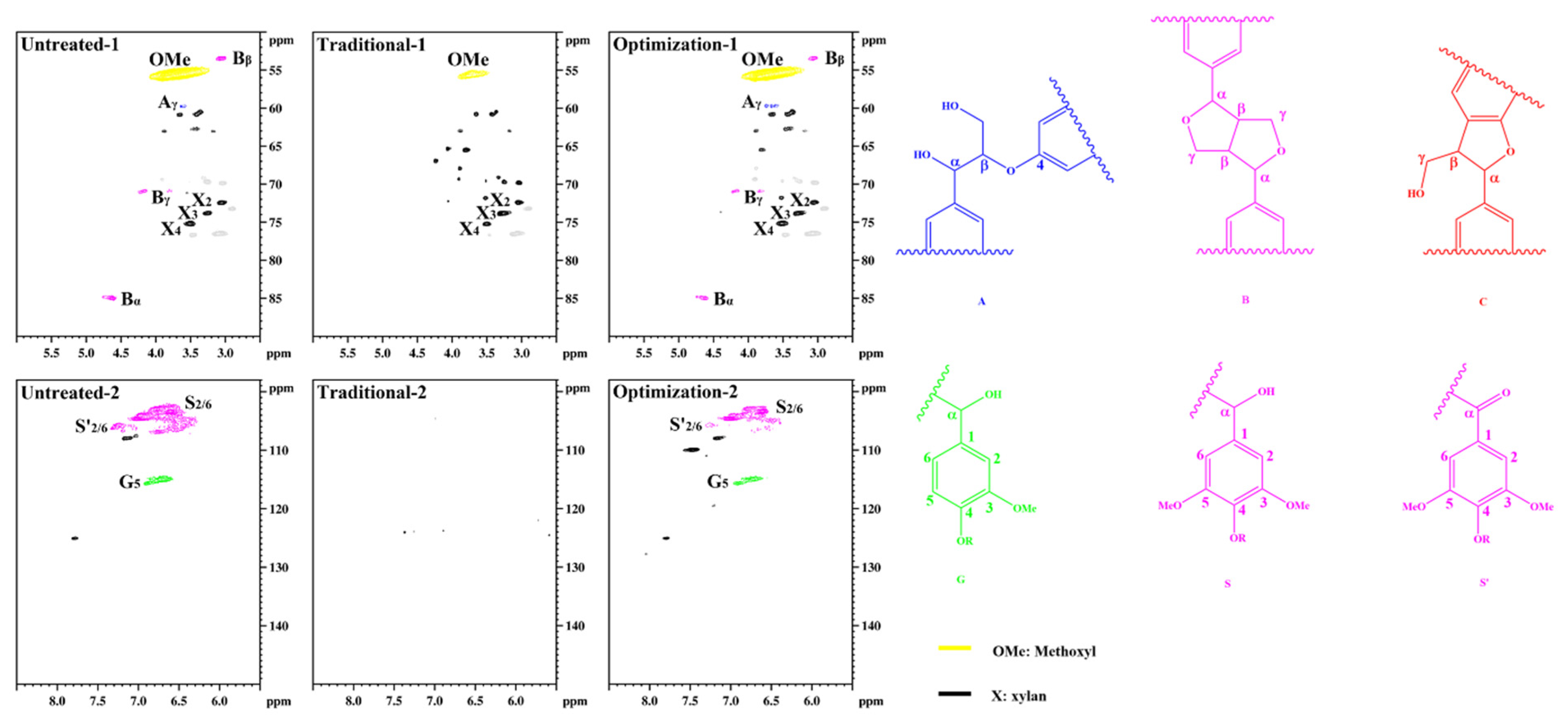
| Serial Number | Retention Time (min) | Relative Content | Substance Name | |
|---|---|---|---|---|
| Traditional Chlorine Dioxide Oxidation | Optimization Chlorine Dioxide Oxidation | |||
| 1 | 29.40 | 1 | 1 | 3,4-dimethoxybromobenzene |
| 2 | 36.39 | 0.6 | 1.0 | veratryl alcohol |
| 3 | 38.53 | 0.1 | 0.1 | vanillyl alcohol |
| 4 | 41.46 | 0.5 | 0.3 | 6-chloro-veratryl alcohol |
| Samples | Brightness (%ISO) | Kappa Number | Viscosity (mPa·s) | AOX (mg·L−1) |
|---|---|---|---|---|
| Untreated | 29.0 | 19.2 | 1014 | / |
| Traditional | 39.2 | 7.5 | 772 | 23.8 |
| Optimization | 41.0 | 8.4 | 834 | 18. 0 |
Publisher’s Note: MDPI stays neutral with regard to jurisdictional claims in published maps and institutional affiliations. |
© 2022 by the authors. Licensee MDPI, Basel, Switzerland. This article is an open access article distributed under the terms and conditions of the Creative Commons Attribution (CC BY) license (https://creativecommons.org/licenses/by/4.0/).
Share and Cite
Liu, Y.; Deng, B.; Liang, J.; Li, J.; Liu, B.; Wang, F.; Qin, C.; Yao, S. Effects of the Preferential Oxidation of Phenolic Lignin Using Chlorine Dioxide on Pulp Bleaching Efficiency. Int. J. Mol. Sci. 2022, 23, 13310. https://doi.org/10.3390/ijms232113310
Liu Y, Deng B, Liang J, Li J, Liu B, Wang F, Qin C, Yao S. Effects of the Preferential Oxidation of Phenolic Lignin Using Chlorine Dioxide on Pulp Bleaching Efficiency. International Journal of Molecular Sciences. 2022; 23(21):13310. https://doi.org/10.3390/ijms232113310
Chicago/Turabian StyleLiu, Yi, Baojuan Deng, Jiarui Liang, Jiao Li, Baojie Liu, Fei Wang, Chengrong Qin, and Shuangquan Yao. 2022. "Effects of the Preferential Oxidation of Phenolic Lignin Using Chlorine Dioxide on Pulp Bleaching Efficiency" International Journal of Molecular Sciences 23, no. 21: 13310. https://doi.org/10.3390/ijms232113310
APA StyleLiu, Y., Deng, B., Liang, J., Li, J., Liu, B., Wang, F., Qin, C., & Yao, S. (2022). Effects of the Preferential Oxidation of Phenolic Lignin Using Chlorine Dioxide on Pulp Bleaching Efficiency. International Journal of Molecular Sciences, 23(21), 13310. https://doi.org/10.3390/ijms232113310








